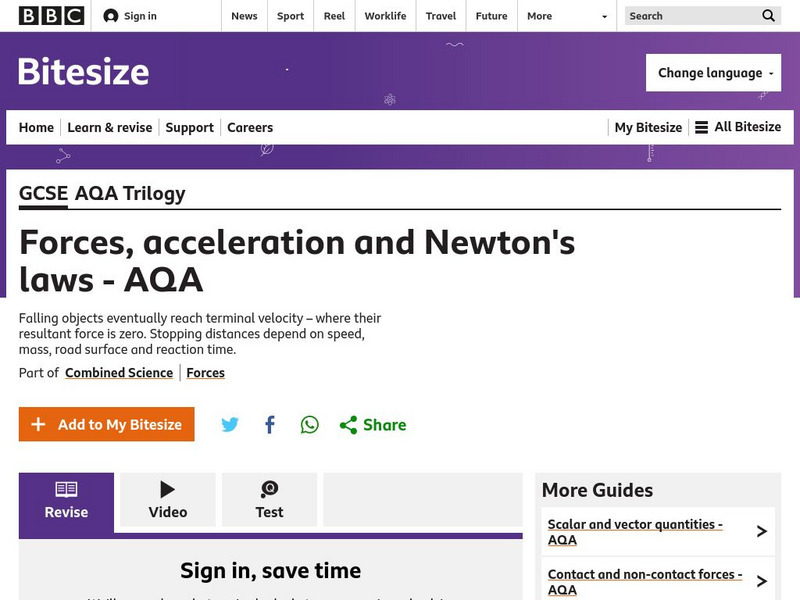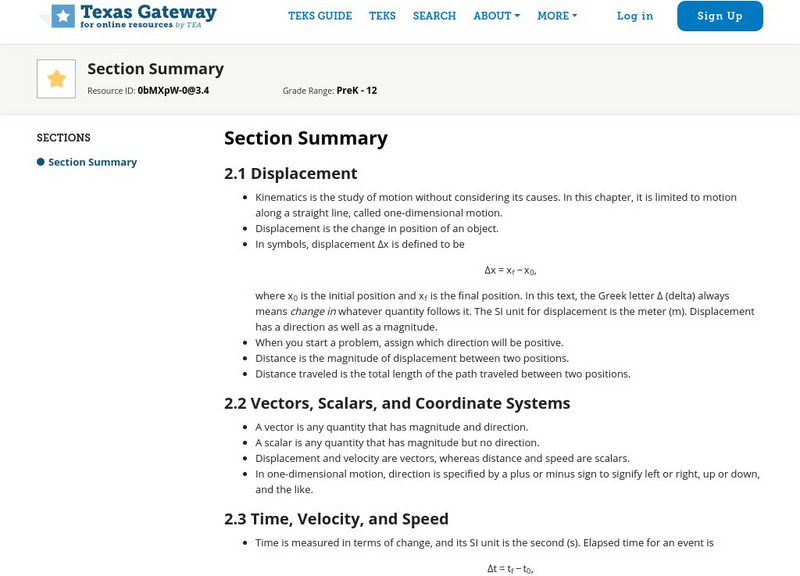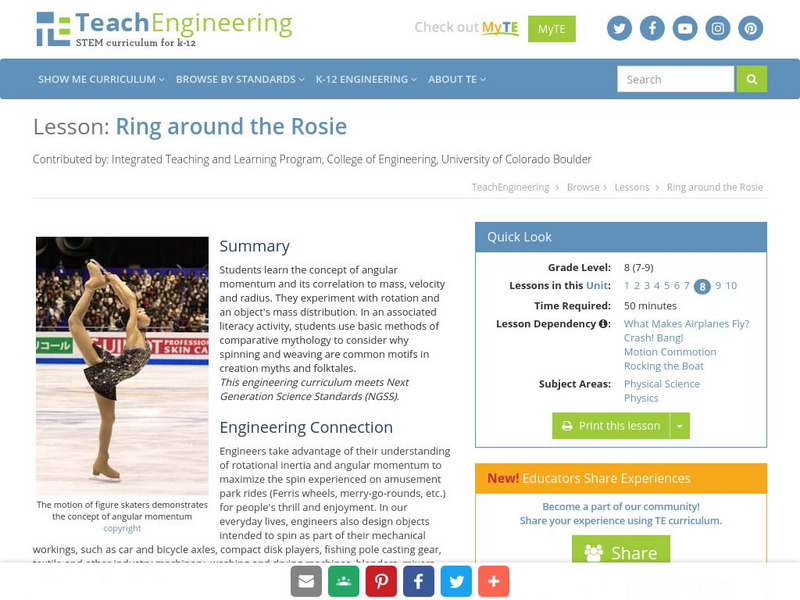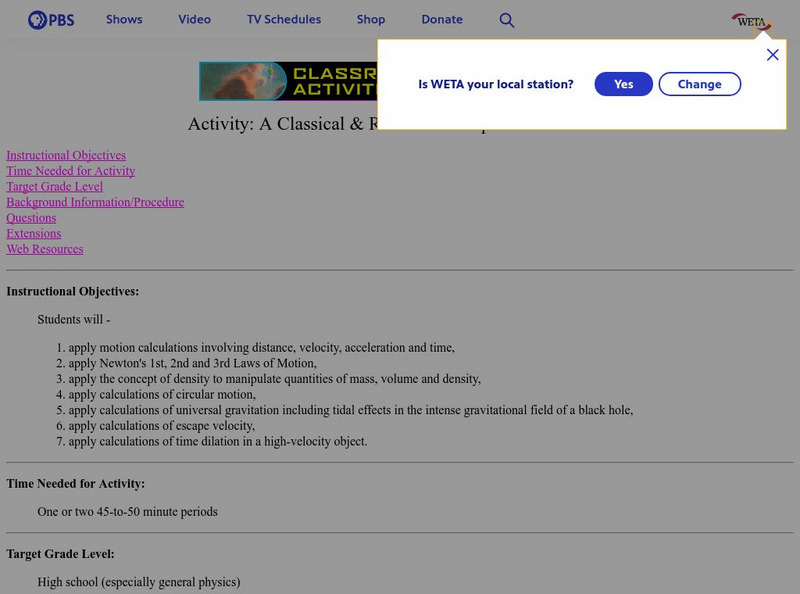Physics Classroom
The Physics Classroom: Vectors and Projectiles: The Truck and the Ball
Imagine a pickup truck moving with a constant speed along a city street. In the course of its motion, a ball is projected straight upwards by a launcher located in the bed of the truck (with no air resistance). This animation depicts the...
BBC
Bbc: Gcse Bitesize: Forces, Acceleration and Newton's Laws Aqa
This lesson focuses on Newton's First Law: an object remains in the same state of motion unless a resultant force acts on it. If the resultant force on an object is zero, this means: a stationary object stays stationary; a moving object...
Physics Classroom
The Physics Classroom: Vectors and Projectiles: The Plane and the Package
Consider a plane moving with a constant speed at an elevated height above the Earth's surface. In the course of its flight, the plane drops a package from its luggage compartment. This animation depicts such a situation. The path of the...
Texas Instruments
Texas Instruments: Classroom Activities: Parachuting
This activity explores a parachutist and her position, velocity and acceleration. Graphing and calculating these functions will be required.
Physics Aviary
Physics Aviary: Practice Problems: High School Toss Level 1
Students will determine maximum height obtained by an object tossed upward off the roof of a high school. They will also find the total time aloft and the speed with which the object will impact the ground. The acceleration due to...
Concord Consortium
Concord Consortium: Stem Resources: Launching a Satellite
Do you think you could fire an "unpowered" object into orbit? By controlling the angle and speed at which the satellite is launch, students will try to launch a satellite into space with this computer model. Activity includes questions...
Alabama Learning Exchange
Alex: The Need for Speed
After viewing an introductory illustrated podcast on speed, distance, time, and velocity, young scholars explore distance-time graphs using interactive websites. Working in cooperative learning groups, students will investigate the...
Khan Academy
Khan Academy: What Is Centripetal Acceleration?
Learn what centripetal acceleration means and how to calculate it. Included are two example problems with solutions.
CK-12 Foundation
Ck 12: Episd: Position Time Graphs
[Free Registration/Login may be required to access all resource tools.] Understand how to evaluate data presented in graphs based on speed and velocity calculations.
TeachEngineering
Teach Engineering: What's Up With All This Traffic?
Expanding on the topic of objects in motion covering Newton's laws of motion, acceleration and velocity, which are taught starting in third grade, students are introduced to new concepts of speed, density, level of service (LOS) (quality...
TeachEngineering
Teach Engineering: What Is Newton's First Law?
Students are introduced to the concepts of force, inertia, and Newton's first law of motion: objects at rest stay at rest and objects in motion stay in motion unless acted upon by an unbalanced force.This lesson is the first in a series...
Khan Academy
Khan Academy: What Is Acceleration?
Provides definitions, examples, and formulas for acceleration.
NASA
Nasa: Beginner's Guide to Aerodynamics
This site from NASA uses a colorful graphic to illustrate why objects reach terminal velocity. Provides equation for the terminal velocity of an object. Graphic is accompanied by a simple explanation.
Texas Education Agency
Texas Gateway: Kinematics Section Summary
This is a summary of the main topics for AP Physics Chapter 2 Kinematics. These include Displacement; Vectors, Scalars, and Coordinate Systems; Time, Velocity, and Speed; Acceleration; Motion Equations for Constant Acceleration in One...
Science and Mathematics Initiative for Learning Enhancement (SMILE)
Smile: The Great Tin Race
This activity is a great way to show distance and time relationships while incorporating charts and graphing. Different sized tins are raced against each other, and data is collected.
Physics Classroom
The Physics Classroom: Acceleration
A GIF animation comparing the motion of three cars. A graphical depiction is given. Includes three thoughtful questions with answers in a pop-up menu.
Stanford University
Stanford University: Conventionality of Simultaneity
This site from Stanford University is on the topic of simultaneity in relativity.
Texas Instruments
Texas Instruments: Vernier a Speedy Slide With Easy Data App and Cbr 2
Students can use a CBR 2 motion detector to determine their speed or velocity going down a playground slide. They will also experiment with different ways to increase their speed going down the slide.
TeachEngineering
Teach Engineering: Super Spinners!
Use this hands-on activity to demonstrate rotational inertia, rotational speed, angular momentum, and velocity. Students build at least two simple spinners to conduct experiments with different mass distributions and shapes, as they...
Physics Aviary
Physics Aviary: Circular Acceleration
This program gives students a visual representation of why an object moving in a circle at constant speed is accelerating. This program will guide students through a method of calculating the circular acceleration based on the change in...
TeachEngineering
Teach Engineering: Ring Around the Rosie
Students learn the concept of angular momentum and its correlation to mass, velocity and radius. They experiment with rotation and an object's mass distribution. In an associated literacy activity, students use basic methods of...
Concord Consortium
Concord Consortium: Molecular Workbench: Maxwell Speed & Velocity Dist.
Adjust the temperature in this simulation to observe the effects to moving particles. Graphs can be created from collected data.
Science Education Resource Center at Carleton College
Serc: Centripetal Force Activity
In this physics activity, young scholars will simulate a race car on a circular track. Velocity, acceleration, and force vectors will be analyzed at various places along the track. As the students progress in the activity, prompts for...
PBS
Pbs: A Classical and Relativistic Trip to a Black Hole
This PBS site is a classroom activity that takes a trip to a black hole. Students apply calculations on distance, velocity, acceleration, time, circular motion, density, and more.





















